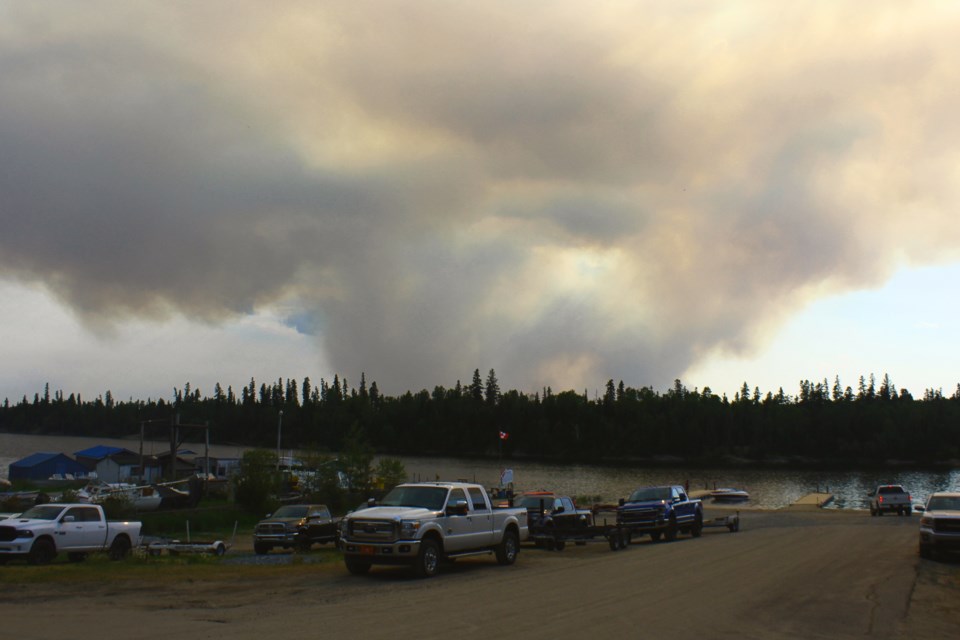Fire season is back with a vengeance in northern Saskatchewan, where dry conditions, lightning strikes and constant heat have turned the region into a tinder box.
As of July 13, 108 fires were burning in the region and 337 fires have started so far this summer, well over the five-year average for the province.
The closest fire to Flin Flon is the Alir fire, located on the west shore of Amisk Lake. That fire, near Muskeg Bay, has grown to over 2,000 hectares in size as of July 13 and was started by a lightning strike July 10. Firefighters in the region are currently at the “protecting values” stage of beating back the flames, according to the Saskatchewan Public Safety Agency (SPSA).
Another fire, called the McKenzie fire by the SPSA, is about 100 hectares in size and burning roughly halfway between Amisk Lake and Cumberland House. The McKenzie fire is considered as “ongoing assessment” by the SPSA.
Most of the fires burning in Saskatchewan as of The Reminder’s press time are burning in the central region around La Ronge, with scattered fires throughout all portions of the north.
A province-wide fire ban is in effect in Saskatchewan, including all recreation areas and provincial parks. Creighton, Denare Beach and other northern communities have added their own fire bans for municipal areas.
People in three northern communities - Dillon, near La Loche and Buffalo Narrows, as well as Grandmothers’ Bay near La Ronge and Southend, located on Reindeer Lake about 150 kilometres north of Flin Flon - are being evacuated due to nearby fires.
The fire picture is not likely to improve this week - another week of high temperatures and low precipitation may make the situation worse later this week. Temperatures in Flin Flon and La Ronge, where several fires are currently burning nearby, are expected to be in the high 20s and low 30s for the rest of the week with showers only expected by the weekend.
SPSA vice president operations Steve Roberts said during a July 12 conference call that the agency is managing the fires with their own resources and personnel and have no plans to call in other agencies. Roberts also said that most jurisdictions where Saskatchewan typically draws from - such as Ontario, B.C. or some American states - are also dealing with forest fires.
“We have no current plans to bring in resources. We are managing the fires with our internal crews, resources and equipment,” he said in the July 12 conference call.
Manitoba
Manitoba’s fire situation is not looking great either, with lightning from a July 11 storm sparking fires all around Flin Flon.
The closest fire to Flin Flin in Manitoba and one of the largest fires currently burning, the WE038 fire, is about 2,000 hectares and is burning about 40 kilometres due north of Flin Flon. Another fire, the WE032 fire, is burning between Sherridon and Snow Lake. That fire has reached 600 hectares in size as of July 13 and two smaller fires are located nearby. All these blazes are listed as "out of control" by Manitoba Sustainable Development as of July 13.
No Manitoba communities have been evacuated due to fires as of press time.
Level three fire and travel restrictions are now in effect for the fire protection area covering Flin Flon, meaning tight limits on fires and backcountry activity in an attempt to stop possible fires. Province-issued burning permits have been cancelled and campfires will not be permitted, along with backcountry travel without a travel permit and camping outside developed campgrounds. Cabin owners will still be able to get to their cabins as long as they are located on or near designated roads - travel to more remote cabins will require province-issued permits.
A total of 86 forest fires are currently burning in Manitoba, with 38 of those fires in the northern part of the province. Sixteen of those fires have started since July 11. A total of 54 firefighters, four helicopters and three other aircraft are being used to shut down the blazes as of July 13.
-
with files from John Cairns, Battlefords News-Optimist




